
Underwater Acoustics International
Conference and Exhibition (UACE2025)
June 15-20, 2025 • Macedonia, Greece
Please join us for a structured session on Marine Bioacoustics at the 8th UACE2025, which will take place in Porto Carras Grand Resort Meliton, Ηalkidiki, Macedonia, Greece, on June 15-20, 2025.
Session Purpose and Scope
This session will cover all aspects of marine bioacoustics including active acoustics, passive acoustics, propagation related to marine life, communication, hearing, and ecology. This session always proves to be an interesting session, is it covers all topics within marine bioacoustics.
Abstracts of papers submitted to Structured Sessions
The authors must submit their abstracts electronically to the Conference Secretariat using the online General Abstract Submission Form no later than January 31, 2025.
Target groups
Scientists and engineers from universities, research institutes, government organizations and industry dealing with all aspects of underwater acoustics. Representatives from naval material commands and procurement offices.
Structure
The conference will comprise a series of structured and regular sessions with oral presentations, as well as of poster sessions. The structured sessions will be organized by key persons actively engaged at the forefronts of research in underwater acoustics and invited papers will be presented by leading international scientists. In addition, most recent research results will be presented in contributed papers forming the basis of regular oral sessions.
Exhibition
An exhibition by leading international manufacturers of state-of-the-art technologies, equipment and services for underwater acoustic measurements, surveys and control of underwater processes was arranged in the central area of the conference space.
The topics of the UACE2025 include:
- Acoustic imaging
- Acoustics in Oil and Gas Production
- Acoustic studies of marine mammals
- Ambient noise: sources, monitoring and long term trends
- Arctic acoustics
- Bioacoustics and Biosonar
- Calibration of sonar and hydrophones
- Detection and remediation of objects on the seafloor.
- Environmental protection
- Experimental facilities
- Fisheries
- Flow generated noise
- Geoacoustics
- Harbour and sea lane protection
- Impact of noise on marine life
- International regulations and their impact
- Inversion methods in underwater acoustics
- Marine ecology
- Marine GIS
- Marine renewables
- Marine soundscapes
- Marine surveys
- Metamaterials
- Mine countermeasures
- Multibeam Sonar and Technology
- New transducer materials
- Noise and vibration from marine piling
- Nonlinear underwater acoustics
- Ocean observatories
- Ocean technology policy
- Oceanographic instrumentation
- Radiated noise from ships and surface platforms
- Risk assessment in underwater acoustic measurements
- Research vessel facilities and instrumentations
- Reverberation and clutter
- ROV's and AUV's and their use in underwater acoustics
- Scattering and fluctuations
- Seabed interactions
- Seafloor characterization
- Seismic acoustics
- Signal and image processing
- Single- and multi-beam sonar advances
- Sound propagation modelling in shallow and deep water
- Sonar performance measurements and modelling
- Synthetic aperture sonar
- Tank experiments
- Target recognition
- Tectonic plate movement monitoring
- Tomography
- Transducer and array technology
- Tsunami detection
- Underwater archaeology
- Underwater communication, navigation and positioning
- Volume scattering and bubbly media
- Vector sensors
- Waterside Security
The following Structured Sessions on topics of current interest in underwater acoustics are currently been organized:
- Acoustics in Ocean Observation Systems
Organizers: Jaroslaw Tegowski, Philippe Blondel, Hanne Sagen - Acoustics in polar environments
Organizers: Espen Storheim, Lora van Uffelen, Oskar Glowacki - Advances in acoustic measurement systems: Technologies and applications
Organizers: Alessandra Tesei, Purnima Ratilal, Matthew Schinault - Comprehensive Nuclear-Test-Ban Treaty Monitoring, and its Civil and Scientific Applications
Organizers: Georgios Haralabus, Mario Zampolli,Peter Nielsen, Tiago Oliveira - Distributed Fiber-Optic Sensing technology for underwater acoustical monitoring
Organizers: Alexander Gavrilov, Evgeny Sidenko, Hefeng Dong - Enhancing underwater acoustic sensing through machine learning
Organizer: Cheng Chi - Inverse Problems in Acoustical Oceanography
Organizers: Julien Bonnel, Stan Dosso - Marine Bioacoustics
Organizer: Jennifer Miksis-Olds - Modeling techniques for underwater acoustic scattering and propagation (including 3D effects)
Organizers: Boris Katsnelson, Pavel S. Petrov - New frontiers in fisheries acoustics: applications, analysis, decision and management tools
Organizer: Victor Espinosa - New methods and theories in underwater acoustic imaging
Organizer: Pengfei Zhang, Peng Wang - Observing the Oceans Acoustically
Organizers: Bruce Howe and Kai Gemba - Pile driving noise
Organizer: Jonas von Pein - Radiated noise from offshore wind construction and its impact on passive acoustic marine mammal monitoring
Organizers: Vincent E. Premus - Seabed Acoustics
Organizers: Megan Ballard, Kevin Lee, Nick Chotiros - Sonar Performance Modelling and Verification: Applications to Active and Passive Sonar
Organizers: Mathieu Colin, Kevin Heaney - Target Echo Strength – Measurements and Modelling
Organizer: David Nunn - Towards Automatic Target Recognition. Detection, Classification and Modelling
Organizers: Johannes Groen, Yan Pailhas, Roy Edgar Hansen, Narada Warakagoda - Uncertainty quantification and machine learning in signal processing
Organizers: Eliza Michalopoulou, Angeliki Xenaki - Underwater acoustic calibration and standards
Organizers: Stephen Robinson, Will Slater - Underwater Communications and Networking
Organizers: Charalampos Tsimenidis, Paul Mitchell, Konstantinos Pelekanakis - Underwater noise in the EU Marine Strategy Framework Directive: implementation, monitoring, assessment and measures
Organizers: Peter Sigray, Aristides Prospathopoulos, Emmanuel Skarsoulis - Underwater noise modelling and measurements
Organizers: David Barclay, Martin Siderius - Underwater Seismoacoustics
Organizers: Nathalie Favretto-Cristini, Paul Cristini - Unmanned vehicles for underwater acoustic surveillance and monitoring
Organizer: Alain Maguer
In cooperation with CCBS Greece, a full-service destination & event management company and professional conference organizer, they have selected and are recommending hotels in various categories, based on the distance from the venue and that they have established reasonable prices exclusively for the UACE2025 participants.
To help with your planning, a number of rooms have been pre-reserved by CCBS GREECE, which is the official accommodation supplier.
CCBS GREECE has established special rates for the UACE2025 participants at the venue hotel Porto Carras Grant Resort Meliton as well as to other hotels in Neos Marmaras and Paradisos area in different room and price categories.

